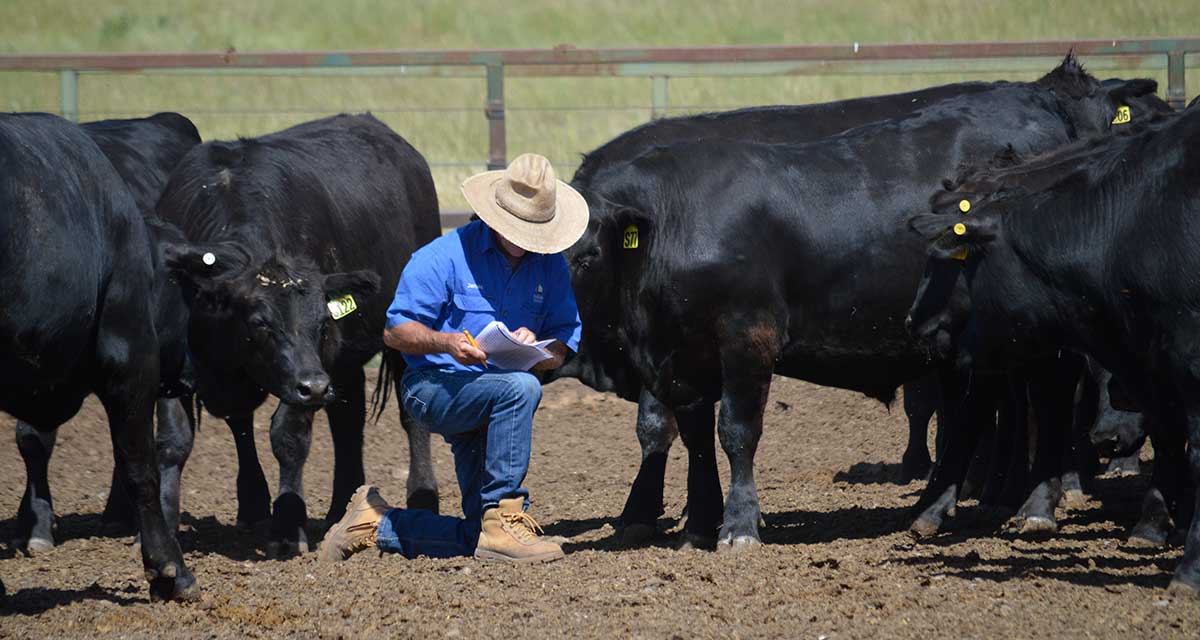Don’t be quiet about Docility


During the recent TransTasman Angus Cattle Evaluation (TACE), a number of significant enhancements were made to the calculation of Estimated Breeding Values (EBVs), including the ability to calculate Docility EBVs on more than 60% more animals than had previously been available.
This enhancement has thrown docility into the spotlight of commercial bull buyer’s decision making by providing an EBV to assist in objectifying the process for animals that may not have previously had the EBV available.
What Docility EBVs indicate and the way breeders should use the EBV has not changed, being that Docility EBVs are estimates of genetic differences between animals in temperament. Docility EBVs are calculated from a subjective assessment of temperament when animals are between 60 to 400 days of age and are expressed in percentage units.
Higher Docility EBVs indicate an animal is expected to produce a higher percentage of progeny with acceptable temperament.
Docility is an important trait and this significance was highlighted in a recent survey of over 1200 beef producers across Australia, which found temperament was the most important trait when selecting a bull (Australian Beef Breeding Insights,2019).
Docility is a trait that can at times also be considered a pass or fail in phenotype expression, meaning so long as the animal does not behave poorly it is often deemed acceptable.
However relying solely on the individuals own display of docility , particularly in older animals that may become conditioned to handling over time, is fundamentally flawed when considering the effect of the trait on the progeny. An example of this is a bull that has been prepared for a show or has become accustomed to handling from a young age may present with an acceptable and calm temperament, however this is a reflection of the good management and should not be confused with the docility that will be inherited by his progeny.
The expectations of the commercial supply chain is that animals will be able to adapt quickly to new environments and overcome stress, returning to their normal state of as quickly as possible. Often this ability to perform can be demonstrated by the results achieved while growing and finishing in grassfed and grainfed situations with an ultimate end point of being processed, often into high value markets.
The temperament of an animal has a large impact on its value within a beef operation, more specifically the way animals behave when being confined or exposed to unusual situations (e.g. being separated from the herd).
Issues commonly experienced with animals of poor docility:
The heritability of docility score on the observed scale was 0.21 (S. F. Walkom,2016) which highlights the importance of docility considering the inheritance of the trait to the progeny.
Docility is moderately heritable with weak but favourable genetic correlations between docility score and the production traits indicates that docility score is largely independent of these traits and that selection to improve temperament can occur without having an adverse effect on growth, fat, muscle and reproduction.
In order to make improvements in docility the trait needs to be recorded in animals. Recording of docility, in line with the collection parameters, allows calculation of Docility EBVs. The EBV takes into account all information in the pedigree and docility records on itself and its relatives, giving the commercial bull buyer an objective tool that better explains the genetic potential of the progeny and the likelihood of the number of calves that will have an acceptable temperament.
By recording docility and analysing it in the TACE analysis, we have the potential to benefit from improved temperament within the breed and as an industry more broadly given significant market penetration of Angus genetics into the broader beef industry. Research is currently underway to incorporate genomic information into the docility analysis in the future.
Looking back on Docility
Since 2003 the breed average for docility has improved by 3%, indicating there is still significant room for improvement in the trait amongst the population.
One of the key reasons improvement has not been higher is that the majority of animals in the TACE analysis could not have had an EBV published without docility trait recording on themselves, their progeny or on closely related animals.
With the recent TACE enhancements released in December 2022, the Docility EBV is available to more than 90% of the animals in the evaluation, which is a game changer for those looking to use this tool for selection. See here for more information on the recent TACE enhancement for Docility.
In 2022 more than 30,000 docility scores were submitted to the TACE analysis. This is up from 5,000 observations submitted in 2020, indicating the importance of docility is fast become a trait of importance common in many breeding objectives across Australia and New Zealand with herds looking to make genetic improvements for themselves, their clients and the broader beef industry.
To learn more about collecting docility information please visit the Angus Education Centre or CLICK HERE
Take Home Messages
– Jake Phillips, Extension Manager